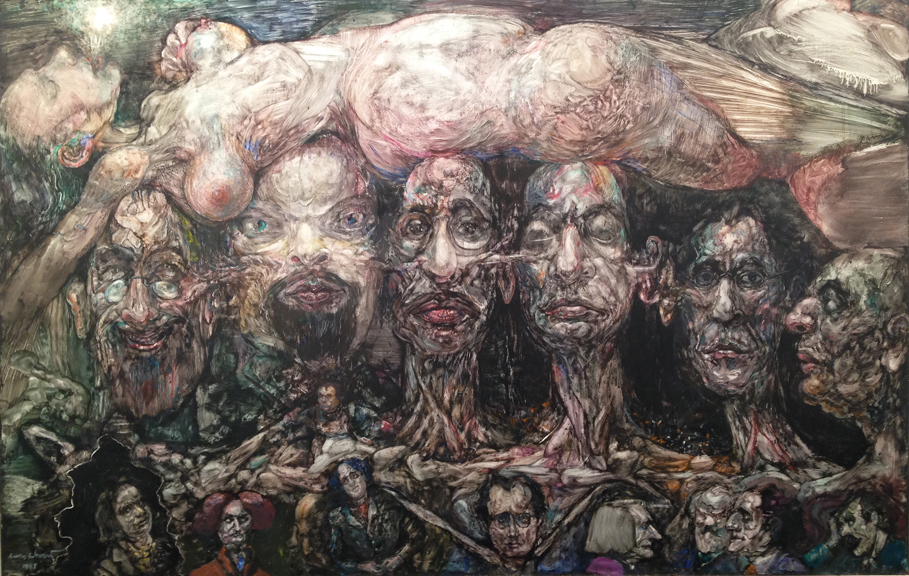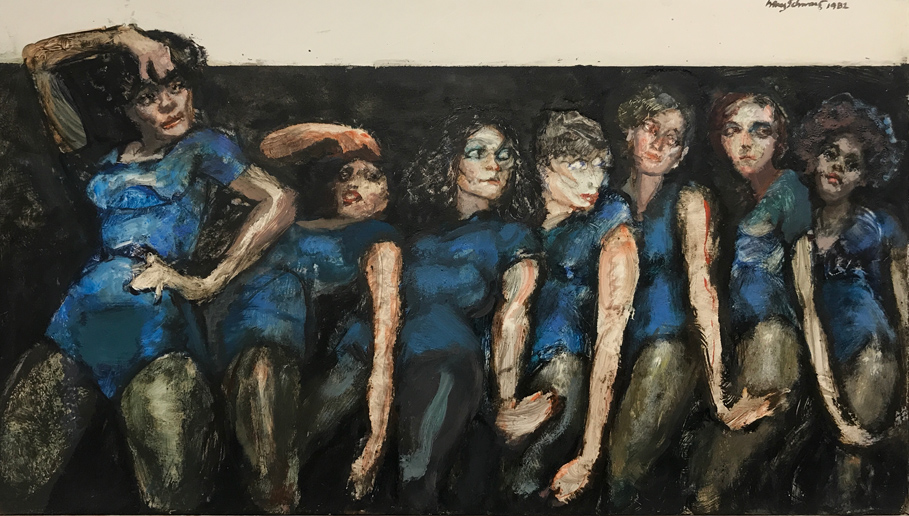Henry Schwartz
Henry Schwartz, born in Winthrop, Massachusetts in 1927, is arguably the most important artist of the second generation of Boston Expressionist painters, successors and students of the great post-World War II figures Hyman Bloom, Jack Levine, and Karl Zerbe. Those figures had the greatest influence on Schwartz during his years at the School of the Museum of Fine Arts from 1948 through 1953.
Schwartz produced a large and philosophically ambitious body of work of great painterly invention and dash. His two primary forms have been, firstly, narrative history paintings and portraits in which figures from cultural and political history are arrayed and examined; and secondly, autobiographical works examining his own, personal world. At times, these strains have merged in a single image.
Henry Schwartz's show in 2012 was recognized by Cate McQuaid in The Boston Globe as one of the best shows of 2012 in Boston-area galleries. "Henry Schwartz, who died in 2009, at 81, could both be considered second-generation Boston Expressionists (granted, Gillespie lived in the Pioneer Valley). Like Bloom, they made emotionally fervent, painterly work," stated Cate McQuaid.
Schwartz's exhibiting career is marked by his 1991 retrospective show at the Fuller Craft Museum, in Brockton, Massachusetts, which brought together four decades worth of paintings in a singular space. His work can be found in the collections of the deCordova Sculpture Park and Museum in Lincoln, Massachusetts, and the Boston Public Library, among others.
The Birth Pangs of Modern Music and the Stretchmarks of History, 1987, oil on board, 31x48" > Inquire Andrea Among Dryads (A Chorus Line), 1982, oil on panel, 10x17.5"> Inquire untitled (chorus line), 1991, oil on museum board, 12x15"> Inquire Bodyharp III The Russians: None but the Lonely Harp, 1988, oil on panel, 28x48"> Inquire Why I Bought My Condo, 1982, oil on board, 31x15"> Inquire Tapiola (Sibelius), 1991, oil on velvet mounted on panel, 24x18"> Inquire untitled (boy with phylactery), c. 1980, oil on panel, 24x16" Sold> Inquire Vienna Blood: Dirty Dancing on the Danube, 1988, oil on panel, 40x96" Sold> Inquire Hamlet, 1967 – 1979, oil on panel, 23x19"> Inquire untitled (dreaming figure), 1991, oil on museum board,18x24"> Inquire
Henry Schwartz
Henry Schwartz, born in Winthrop, Massachusetts in 1927, is arguably the most important artist of the second generation of Boston Expressionist painters, successors and students of the great post-World War II figures Hyman Bloom, Jack Levine, and Karl Zerbe. Those figures had the greatest influence on Schwartz during his years at the School of the Museum of Fine Arts from 1948 through 1953.
Schwartz produced a large and philosophically ambitious body of work of great painterly invention and dash. His two primary forms have been, firstly, narrative history paintings and portraits in which figures from cultural and political history are arrayed and examined; and secondly, autobiographical works examining his own, personal world. At times, these strains have merged in a single image.
Henry Schwartz's show in 2012 was recognized by Cate McQuaid in The Boston Globe as one of the best shows of 2012 in Boston-area galleries. "Henry Schwartz, who died in 2009, at 81, could both be considered second-generation Boston Expressionists (granted, Gillespie lived in the Pioneer Valley). Like Bloom, they made emotionally fervent, painterly work," stated Cate McQuaid.
Schwartz's exhibiting career is marked by his 1991 retrospective show at the Fuller Craft Museum, in Brockton, Massachusetts, which brought together four decades worth of paintings in a singular space. His work can be found in the collections of the deCordova Sculpture Park and Museum in Lincoln, Massachusetts, and the Boston Public Library, among others.










